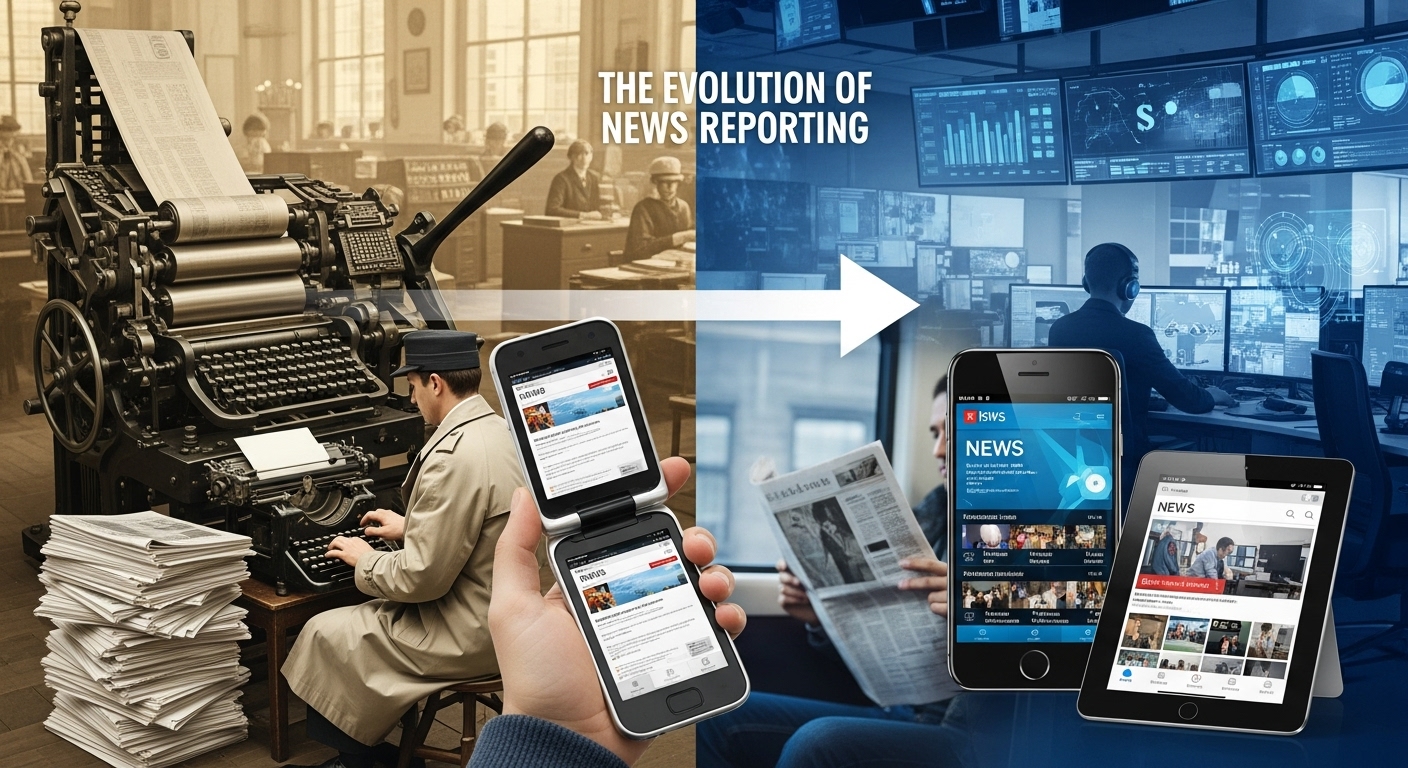
The Evolution of News Reporting: From Print to Digital Era
The world of news reporting has undergone a dramatic transformation over the past few decades. From the dominance of newspapers in the early 20th century to the rapid rise of digital platforms, the way we consume news today is vastly different from previous generations. This evolution has not only changed the format of news but also its immediacy, accessibility, and the role of journalists. In this blog post, we will explore the journey of news reporting, examining the key milestones that have defined its evolution and the implications for the future.
The Golden Age of Print Media
At the turn of the 20th century, print media was the cornerstone of news dissemination. Newspapers were the primary source of information, with major publications like The New York Times and The Guardian setting the standard for journalism. This era, often referred to as the “Golden Age of Print Media,” was characterized by in-depth reporting, investigative journalism, and the rise of influential journalists who shaped public opinion. Print media held significant power, and circulation numbers were a testament to a publication’s influence.
During this time, newspapers were not just sources of news but also cultural touchstones. They were instrumental in educating the public, campaigning for social change, and serving as watchdogs of democracy. The print era was marked by the meticulous process of gathering, verifying, and reporting news, which often meant that stories took time to develop. However, the trade-off was comprehensive, thoroughly-researched news coverage.
The Advent of Television and Radio

The introduction of radio and television in the mid-20th century began to alter the landscape of news reporting. Radio brought news into people’s homes in real-time, and television added a visual dimension, making news more engaging and immediate. This shift provided audiences with not only the latest news but also dynamic storytelling through images and live broadcasts.
With the launch of 24-hour news channels like CNN in the 1980s, television news became more immediate and accessible. The concept of breaking news emerged, and viewers could witness events as they happened. This era also saw the rise of iconic news anchors who became trusted figures in households around the world.
The Rise of the Internet and Digital News
The digital revolution in the late 20th and early 21st centuries marked a turning point in news reporting. The internet democratized information dissemination, allowing anyone with an internet connection to access news from around the globe. Online news websites emerged, offering real-time updates and a wide variety of perspectives.
This era saw the emergence of new players in the news industry, such as digital-native platforms like Huffington Post and BuzzFeed, which catered to changing audience preferences. Social media platforms like Facebook, Twitter, and Instagram further disrupted traditional news models, enabling users to share and consume news instantaneously. This shift challenged traditional media’s authority, as citizen journalists and influencers began to shape news narratives.
Challenges and Opportunities in the Digital Era
The digital era brought new challenges to the news industry. The pressure to deliver news rapidly often led to concerns about accuracy and the spread of misinformation. With the abundance of information available online, distinguishing credible sources became increasingly difficult. This phenomenon raised ethical questions about the responsibility of journalists and platforms in curbing false information.

On the other hand, the digital era also presented numerous opportunities. News organizations could reach a global audience, harness data analytics to understand reader preferences, and engage with audiences through interactive content. The rise of multimedia storytelling allowed journalists to present news in innovative ways, combining text, video, and graphics to enrich the audience’s experience.
The Future of News Reporting
As technology continues to evolve, so will the future of news reporting. Artificial intelligence and machine learning are beginning to play roles in news curation, with algorithms helping to deliver personalized content to users. Virtual reality and augmented reality offer immersive storytelling possibilities that could revolutionize how news is experienced.
The future of news may also entail a greater emphasis on subscription models and paywalls, as organizations seek sustainable revenue streams in a digital world where advertising revenue is no longer guaranteed. Moreover, the importance of media literacy will grow, as educating the public to discern credible news sources becomes crucial in combating misinformation.
Takeaways
The evolution of news reporting from print to the digital era has been a journey of adaptation and transformation. With each technological advancement, news organizations and journalists have faced new challenges and opportunities. As we look to the future, the landscape of news reporting will undoubtedly continue to evolve, driven by innovation and the ever-changing expectations of audiences worldwide.

Despite the uncertainties that lie ahead, the core mission of journalism remains steadfast: to inform, educate, and empower the public. Whether in print, on television, or online, the pursuit of truth and accountability remains at the heart of news reporting. As consumers of news, it is our responsibility to engage critically with the information we encounter and support the integrity of journalism in whatever form it may take.
The Role of Social Media in News Reporting
Social media has transformed how news is reported and consumed. Platforms like Twitter and Facebook have become integral to the news ecosystem, offering real-time updates and enabling users to participate in the news cycle as both consumers and contributors. The role of social media in disseminating news is profound, as it allows stories to reach vast audiences rapidly.
However, this immediacy comes with challenges. The spread of misinformation on social media can be swift, and the difficulty of verifying sources means that false narratives can gain traction quickly. News organizations now face the dual task of engaging with audiences on these platforms while ensuring the integrity of their reporting.
Social media’s influence is also evident in the way stories are shaped. Trending topics can dictate news coverage priorities, and the engagement metrics of likes, shares, and comments often impact editorial decisions. This shift towards audience-driven content presents both opportunities for greater engagement and challenges in maintaining journalistic standards.
Embracing Multimedia and Interactive Storytelling

In the digital era, multimedia and interactive storytelling have become essential tools for news organizations. These formats allow journalists to present complex stories in engaging and accessible ways. For instance, data visualizations and interactive maps can help readers understand intricate topics such as climate change or election results.
Video content has also gained prominence, with platforms like YouTube and TikTok becoming popular venues for news consumption. These platforms enable journalists to reach younger demographics that might not engage with traditional forms of news. The use of interactive storytelling enhances user engagement, allowing audiences to explore stories at their own pace and delve deeper into areas of interest.
Furthermore, podcasts have emerged as a significant medium for news reporting. Their on-demand nature and ability to cover topics in depth make them appealing to audiences seeking detailed analysis and commentary. This diversification of formats is a testament to the adaptability of news organizations in meeting the evolving preferences of their audiences.
Ethical Considerations in Modern Journalism
As news reporting continues to evolve, ethical considerations remain at the forefront of journalism. The challenges of misinformation, bias, and the ethics of using user-generated content pose significant questions for news organizations. As gatekeepers of information, journalists must uphold the principles of accuracy, fairness, and impartiality.
The digital age has also highlighted the importance of privacy and consent, particularly when reporting on sensitive topics or using content sourced from social media. Journalists must navigate these ethical dilemmas carefully, balancing the public’s right to know with the rights and dignity of individuals.

Moreover, the rise of technology has introduced new ethical concerns, such as the use of AI in generating news content. As these technologies become more prevalent, the journalism industry must establish guidelines to ensure that the use of AI aligns with ethical journalism standards.
Globalization and the Democratization of News
The digital era has facilitated the globalization of news, enabling stories to transcend geographical boundaries. International news coverage has become more accessible, allowing audiences to gain a broader understanding of global events. This interconnectedness has fostered a more informed public and encouraged cross-cultural dialogue.
However, the democratization of news has also led to the proliferation of information sources, some of which may lack credibility. As a result, media literacy has become increasingly important, empowering individuals to critically evaluate the news they consume and recognize reputable sources.
In this globalized landscape, collaboration between international news organizations has become more common, pooling resources to cover significant global events comprehensively. This trend not only enhances the quality of reporting but also promotes a more nuanced understanding of complex international issues.
Conclusion: The Ever-Evolving Landscape of News Reporting
The evolution of news reporting from print to the digital era has been a journey marked by innovation, challenges, and opportunities. Each phase of this evolution has brought new dynamics to the industry, from the meticulous reporting of the print era to the immediacy and interactivity of the digital age.
As we look towards the future, the landscape of news reporting will continue to evolve in response to technological advancements and changing audience behaviors. The core values of journalism, however, will remain unchanged: to inform, educate, and hold power to account. In navigating this ever-changing environment, both journalists and audiences must remain vigilant in championing credible, ethical, and impactful journalism for the betterment of society.




